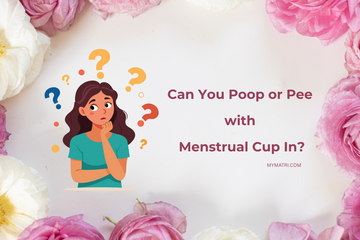Menstrual cups are a popular alternative to pads and tampons for many people due to their convenience, comfort, and eco-friendliness. However, one question that frequently arises is whether it's possible to go about normal bodily functions, such as urination or bowel movements, while wearing a menstrual cup. In this article, we’ll explore how menstrual cups work and answer the common concern: Can you poop or pee with a menstrual cup in?
New to cups? This beginner’s guide to menstrual cups walks you through everything from choosing the right size to insertion and removal, perfect for first-timers looking for confidence and clarity.
How Menstrual Cups Work
Menstrual cups are small, flexible devices made of medical-grade silicone, rubber, or elastomer that are inserted into the vagina to collect menstrual blood. Unlike tampons, which absorb blood, a menstrual cup collects it, and it can hold much more fluid, making it suitable for longer wear time – up to 12 hours in some cases.
The cup is designed to create a seal in the vaginal canal, preventing leakage and allowing for a leak-free period. Most menstrual cups come with a stem at the base to make removal easier, and they come in different sizes to suit individual needs. When used correctly, menstrual cups can be worn during normal activities, including sleeping, exercising, and using the restroom.
Proper insertion is key to comfort and leak prevention. Follow this step-by-step menstrual cup guide with illustrations to ensure correct placement and sealing, especially helpful if you're new to using a cup or experiencing discomfort.
Can You Pee with a Menstrual Cup In?
Yes, you can absolutely pee with a menstrual cup in. The position of the menstrual cup in the vagina does not interfere with the urethra or the process of urination. The cup sits in the vaginal canal, while urination happens through the urethra, which is located in front of the vagina. Since these two functions occur in different anatomical areas, you can use the restroom normally while wearing a menstrual cup.
However, some users may initially feel a slight discomfort or sensation due to the cup being positioned inside the vaginal canal. This is usually due to an improper fit or positioning, so ensuring the cup is placed correctly can prevent any discomfort while urinating. If you feel any irritation or discomfort while peeing, it’s advisable to adjust the menstrual cup or check the fit.
Can You Poop with a Menstrual Cup In?
Yes, you can poop with a menstrual cup in, but it might take some practice. The placement of the menstrual cup typically does not interfere with bowel movements. The cup is located inside the vagina, and the bowel movement happens through the rectum, which is positioned differently in the body. However, if the cup is positioned too low or is not inserted properly, the pressure from a bowel movement may cause discomfort.
Most people find that once they get used to wearing a menstrual cup, they can go about their normal routine without thinking much about the cup. However, if you experience any discomfort or feel that the menstrual cup is dislodging during bowel movements, you may want to adjust the cup’s position or remove it temporarily for comfort.
Menstrual Cup Position and Comfort
The position of the menstrual cup is crucial for both comfort and effectiveness. When properly inserted, the cup should rest low in the vaginal canal, but it should not be so low that it is at risk of being dislodged by normal activities, such as sitting or using the bathroom. It is recommended that you ensure the menstrual cup forms a seal and that you check its position periodically to avoid discomfort.
If you feel like the cup is shifting or pushing against the vaginal walls during bowel movements or urination, it may be helpful to try a different size or type of menstrual cup, as everyone’s body is unique.
Even a well-inserted cup can leak if it’s not sealed properly. Learn the common causes of cup leaks and how to fix them for a worry-free period experience, especially during physical activity or sleep.
Menstrual Cup and Bowel Movements
While it is generally safe to have a bowel movement with a menstrual cup in, some users may find that pressure from the rectum can dislodge the cup if it is not securely placed. If the cup is properly fitted, there should be no issue with it moving or causing discomfort during bowel movements. However, if you notice that the cup shifts or becomes uncomfortable during this time, you may need to experiment with adjusting the position or removing it during particularly intense bowel movements.
It’s important to note that while a menstrual cup can be worn during most daily activities, some individuals may find it more comfortable to remove the cup temporarily during bowel movements, particularly if they have larger or more frequent bowel movements. This can be a personal choice, and there’s no harm in removing it for a few minutes during this time.
If you experience severe cramps along with your period, a drug-free solution like the Matri Pro pain relief device can provide effective comfort. It's designed to ease menstrual pain naturally using TENS technology, without any side effects.
Advantages of Using a Menstrual Cup
- Eco-friendly: Menstrual cups are reusable, which makes them an environmentally friendly option compared to disposable products like tampons and pads.
- Cost-effective: Once purchased, menstrual cups can last for years, making them a cost-effective choice compared to the ongoing costs of tampons and pads.
- Longer wear time: Menstrual cups can hold more menstrual fluid than pads and tampons, which means they can be worn for up to 12 hours, providing convenience and comfort.
- Better for sensitive skin: Since menstrual cups don’t contain any synthetic fibers, chemicals, or fragrances, they are less likely to irritate sensitive skin.
-
Discreet and comfortable: Once inserted, menstrual cups are virtually invisible and can be worn under clothes with no noticeable bulge or discomfort.
Potential Concerns When Using a Menstrual Cup
While menstrual cups are generally safe and comfortable for most people, some individuals may experience issues such as leakage, discomfort, or difficulty with insertion and removal. These issues can often be solved by ensuring proper fit and practice. In rare cases, some individuals may be sensitive to the material of the menstrual cup, so it’s important to choose a high-quality product made from medical-grade silicone or rubber.
FAQs
1. Can a menstrual cup cause urinary problems?
No, a menstrual cup does not affect urination. The menstrual cup sits inside the vaginal canal, while the urethra (where urine exits) is separate from this area. Therefore, using a menstrual cup should not cause any urinary issues when used correctly.
2. Can you poop with a menstrual cup in?
Yes, you can poop with a menstrual cup in. The cup is positioned inside the vagina, while bowel movements happen in the rectum. As long as the cup is inserted correctly, there should be no issue with using the restroom during a bowel movement.
3. How do I know if my menstrual cup is in the correct position?
You can tell if your menstrual cup is in the correct position by checking for comfort and ensuring there is no leakage. The cup should sit low in the vaginal canal, with the stem just out of reach. If you feel discomfort or leakage, the cup may need to be adjusted.
4. Can I use a menstrual cup while swimming?
Yes, you can use a menstrual cup while swimming. Since the cup collects menstrual fluid rather than absorbing it, it will stay in place and not cause leaks, making it ideal for water activities like swimming or snorkeling.
5. Is it okay to use a menstrual cup during exercise?
Yes, it is completely fine to use a menstrual cup during exercise. Once inserted correctly, the cup is secure and will not interfere with most types of exercise, including running, yoga, or weightlifting.







384jur
ol3m97